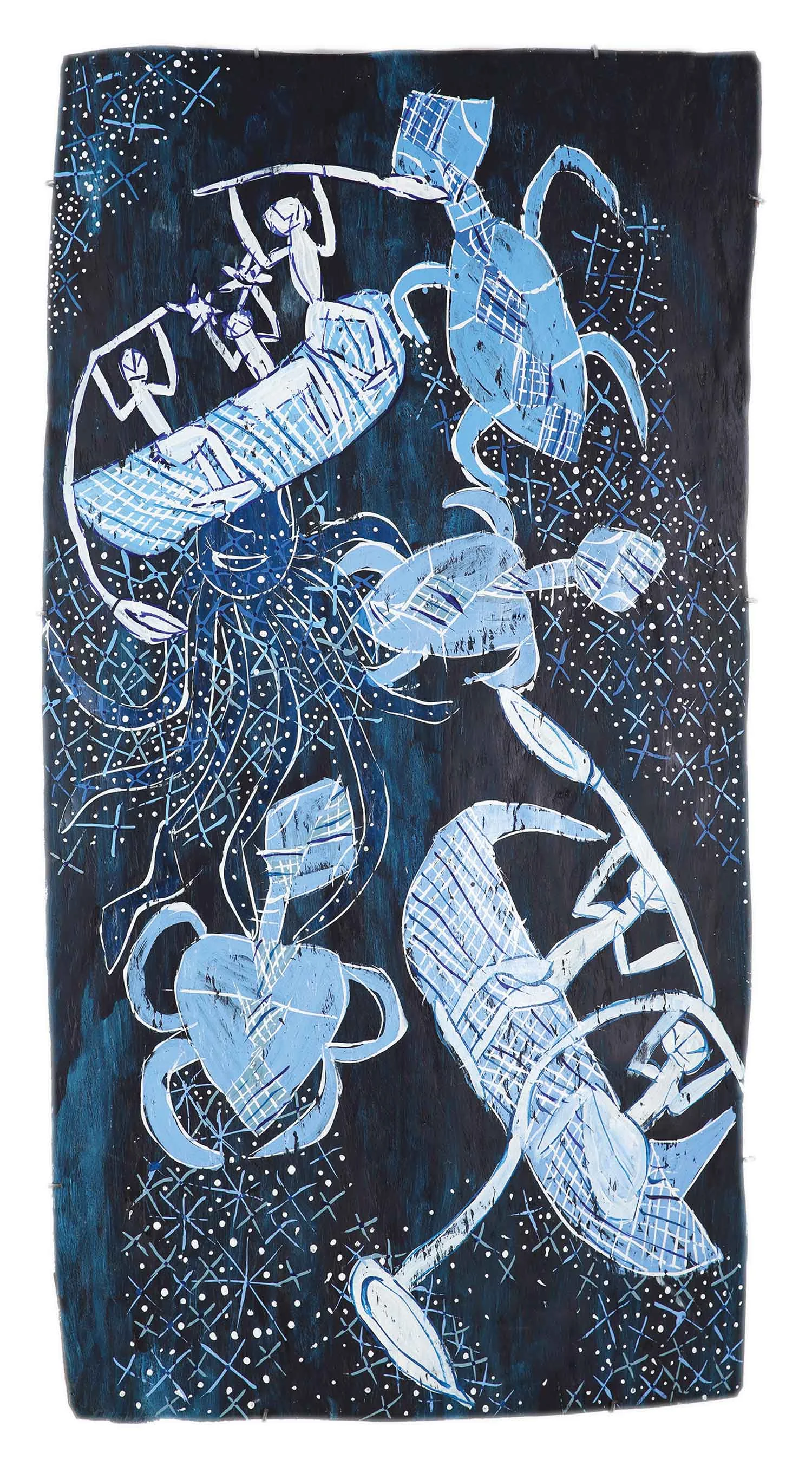Dhambit Mununggurr
15 Aug
BUKU-LARRNGGAY MULKA CENTRE
SALON PROJECT SPACE
1/3 Vickers Street
Parap
OPENING HOURS
Tues to Fri 10 am – 5 pm
Sat 10 am – 2 pm
“Dhambit is a rock.
A rock which stands on the beach near Galiwinku on Elcho Island. A monolith unmoveable by the winds of change or the vagaries of fortune. The identity and power of that giant boulder is embedded in sacred song.”
Dhambit Munuŋgurr is named from this song and identifies herself as this rock.
Dhambit is the daughter of two winners of the First Prize in the National Aboriginal and Torres Strait Islander Art Award (NATSIAA)! Her father Mutitjpuy Munuŋgurr won First Prize in 1990 with a classic Djapu clan bark of the country known as Balana. Her mother, Gulumbu won the same award in 2004 with a tryptich of larrakitj (memorial poles) covered in the stars of the Universe. Her paternal grandfather is Woŋgu and her maternal grandfather is Munggurrawuy. These two men are giants of the post-contact era, each renowned as legendary leaders and artists. Her maternal uncles Galarrwuy and Mandawuy are each Australians of the Year (1978 and 1993 respectively).
She was hit by a car in 2007 and suffered serious head injuries which were life threatening. She is currently in a wheelchair with restrictions on movement and speech stemming from those head injuries. Through her husband’s and now deceased mother’s persistence and her own courage she has used art to overcome the deficits caused by the accident. She practised as an artist prior to the accident and was credited as an artist in the film Yolŋu Boy. Following the accident Dhambit trained herself to paint with her non-preferred left hand.
She is prolific and generous. She paints every day on whatever substrate she can find. She gifts art continuously to any and all people she comes into contact with, Indigenous or otherwise. As such a large percentage of homes within North East Arnhem display a Dhambit work.
It is the nature of her practice that she uses acrylic paint on bark or board. A practical reason for this is that grinding ochres would be an onerous task because of her limited dexterity with her right hand.
She has always been an independent artist who creates and then sells or gives her art without needing the art centre to be involved. At the same time, Buku has always bought her art when it suited her to sell it to us going back even before her accident. The normal stricture requiring art to be made with natural materials was of course relaxed in her case to allow acrylic paint.
She created a large bark painted with acrylic at Buku-Larrŋgay Mulka for the 2018 NATSIAA which excited great interest and was acquired by a major institution and led to another major commission. This was something of a watershed as she enjoyed the process of working on a large piece over a week or more as opposed to finishing multiple works in a day.
This change had an electric effect on her enjoyment of creation and she has made the long drive from her home at Gunyaŋarra to Yirrkala almost every day to paint. She paints on the large barks her husband Tony prepares for her at a table in the courtyard at Buku. She has her own speaker playing Yothu Yindi, Eagles and sacred manikay. She welcomes any of the people who find their way into that courtyard and talks them through the sacred foundation of the work she is involved with at that time.
The works she had done had always included a few colours outside the normal Yolŋu colour palate such as green but in early 2019 she shifted dramatically to a primarily blue genre. It might be that this suite of paintings is the first such batch of blue barks ever created.
She is continuing the role of ambassador for the identity of the country that is the birthright and duty of a niece of the lead singer of Yothu Yindi, Dr. M. Yunupiŋu, whose fire she represents. In every one of these paintings there are coded references to her manifold connections to relatives and places which are interwoven through song and design into the Law.
Her art is powerful and spontaneous and founded in her deep knowledge of Yolŋu Law. Her art is not ‘disabled’ art and finds acceptance within the community and the market as an innovative vision based on real understanding of the spiritual forces of her Yolŋu country and worldview. Dhambit has a level of knowledge of deep Rom or Law which is rare. This is a legacy of her parent’s inculcation in her of esoteric high order knowledge.
As well as being art that does not mimic others and which presents a fresh perspective in Yolŋu designs this is art made for a higher purpose. She has essentially used art and her parent’s sacred teachings to overcome physical handicaps and limitations. Her capacity to communicate through and around art with allcomers is truly inspiring.
She paints without thought or hope of reward. It is her link to health and life through the knowledge of her incredible forebears.
Dhambit is a rock.
– WILL STUBBS, Buku-Larrnggay Mulka Centre
PHOTOGRAPHY BY FIONA MORRISON
IMAGE: Bonba –Butterflies (detail), 2019, acrylic on bark, 205 x 84 cm, 2210-19













